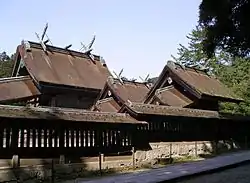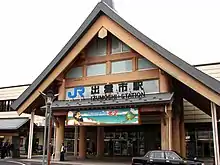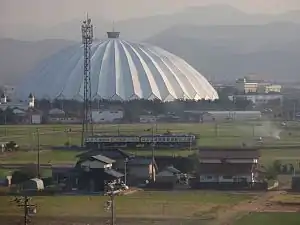Izumo, Shimane
Izumo (出雲市, Izumo-shi) is a city in Shimane Prefecture, Japan. Izumo is known for Izumo soba noodles and the Izumo Taisha Shinto shrine.
Izumo
出雲市 | |||||||||||
|---|---|---|---|---|---|---|---|---|---|---|---|
 Izumo Taisha | |||||||||||
 Flag  Emblem | |||||||||||
 Location of Izumo in Shimane Prefecture | |||||||||||
 Izumo Location in Japan | |||||||||||
| Coordinates: 35°22′N 132°46′E | |||||||||||
| Country | Japan | ||||||||||
| Region | Chūgoku (San'in) | ||||||||||
| Prefecture | Shimane Prefecture | ||||||||||
| Government | |||||||||||
| • Mayor | Hideto Nagaoka | ||||||||||
| Area | |||||||||||
| • Total | 624.36 km2 (241.07 sq mi) | ||||||||||
| Population (March 1, 2017) | |||||||||||
| • Total | 172,039 | ||||||||||
| • Density | 280/km2 (710/sq mi) | ||||||||||
| Time zone | UTC+09:00 (JST) | ||||||||||
| City hall address | 109-1 Imaichichō, Izumo-shi, Shimane-ken 693-8530 | ||||||||||
| Website | www | ||||||||||
| |||||||||||

History
Izumo Taisha is the oldest Shinto shrine in Japan. In 2008, the holy area was open to the public from 1 August until August 17, after which extensive renovation work began. The nearby Shimane Museum of Ancient Izumo,[1] also located in Taisha Machi, has artifacts from the site.
In 2009, a team of archaeologists announced that they likely discovered—at the Sunabara Remains in Taki-chō, Izumo City—the oldest stone tools ever found in Japan. The find totaled about 20 tools dating back an estimated 120,000 years: about 80,000 years earlier than previous estimates of when the first humans arrived in the Japanese archipelago. The stones were found directly across Route 9 from Kirara Taki beach on the Sea of Japan. The excavation team was led by Doshisha University professor Kazuto Matsufuji, and the first of the tools were unearthed by Toshiro Naruse, a professor emeritus at Hyogo University of Teacher Education.[2]
In Izumo, there are various tombs and temples, including an ancient cluster of tombs to the south of the station. Within this tomb cluster is located the largest Tumulus style tomb within the Izumo region. With an overall length of 100 metres and mound 6 metres in height, the tomb located behind the Dainenji Temple is believed to have been constructed in the 6th century with highly sophisticated construction methods for the time.[3]
The Takase River is a canal that runs through the center of Izumo. Beginning at the Hiikawa River, the canal runs directly across the town. Constructed by developer Okaji Shichibei in 1670, the Takase was the first canal ever constructed in the then-Matsue domain. Before Okaji began his agricultural developments, the Izumo area was infertile and unable to support crops. Thanks to Okaji's developments, the area became an important region for the growing of rice and grain in the Matsue area.[4]
Izumo Dome is a venue located just north of the city proper. It has the distinction of being Japan's largest wooden building, at 49 metres high and 143 metres in diameter. It is used for sports and events such as baseball games and soccer matches, as well as for other events including sumo. It is a prominent symbol of Izumo, and can be seen from a distance from the train passing towards Hamada.
Hinomisaki Lighthouse (日御碕灯台, Hinomisaki tōdai) is a modern stone lighthouse with a powerful lamp. From the tower, one can see the Oki Islands, from where the story of the "white rabbit" comes.
Shimane Winery[5] is known for its super-sweet wines.
"Kirara Taki" Beach is located in Taki (多伎町), one of the towns merged into Izumo in 2005. The beach has clean water and off-shore stacks of concrete tetrapods to break the waves. Nearby is an onsen called Marine Thalasso Izumo.
The Okuizumo Museum of Tatara and Sword-making features demonstrations twice a month, switching off every two weeks: one demonstration shows smithing techniques, while the other is a usage demonstration.
The Izumo Handicraft Museum is set in a traditional Japanese workshop complex.
Demographics
The modern city was founded on November 3, 1941. As of 2017, the total population is 172,039 and the area of the new city of Izumo is 624.36 km².
On March 22, 2005, Izumo absorbed the city of Hirata, and the towns of Koryō, Sada, Taisha and Taki (all from Hikawa District) to create the new and expanded city of Izumo.
On October 1, 2011, the town of Hikawa (also from Hikawa District) was also merged into the new Izumo. Hikawa District was dissolved as a result of this merger.
Transportation

Izumo is serviced by two rail networks. The first is the JR West Sanin Main Line, connecting Izumo-shi Station to Tottori through Yonago and Matsue to the east, and connecting along the coast to Ōda, Hamada and Masuda to the west. The secondary rail network is the private Ichibata Electric Railway. Dentetsu Izumo-shi Station is the terminal, and the line runs from Izumo to Matsue, passing through and connecting Hirata. The Dentetsu line also branches out and runs to Izumo Taisha from Kawato Station. A JR West service to Taisha ran until 1990 when the line was closed and Izumo-Takamatsu and Arakaya stations removed. Taisha JR railway station still exists as a historic building.
There is one airport inside the city of Izumo, Izumo Airport, located in the former town of Hikawa.
 Izumo Dome
Izumo Dome Kojindani archaeological site
Kojindani archaeological site Shimane Prefectual Izumo Ancient Museum
Shimane Prefectual Izumo Ancient Museum Inasa beach
Inasa beach Hinomisaki Lighthouse
Hinomisaki Lighthouse
International relations
Izumo has a town twinning relationship with the following cities.
 Santa Clara, California, USA (1986)[6]
Santa Clara, California, USA (1986)[6] Hanzhong, China (1996)
Hanzhong, China (1996) Évian-les-Bains, France (2002)
Évian-les-Bains, France (2002) Kalajoki, Finland (2003)
Kalajoki, Finland (2003) Dún Laoghaire, Ireland (2008)[7]
Dún Laoghaire, Ireland (2008)[7]
See also
References
- Shimane Museum of Ancient Izumo
- The Japan Times, (October 1, 2009), "Tools may rewrite Paleolithic Japan", accessed 11-25-2009
- "Hometown Homepage - Izumo Places to Visit". Hometown.infocreate.co.jp. 2006-10-20. Retrieved 2014-03-13.
- "Hometown Homepage - Izumo A Local Celebrity". Hometown.infocreate.co.jp. 2006-10-20. Retrieved 2014-03-13.
- "島根ワイナリー - 水と緑と青い空・・・彩り豊かなワイナリーへようこそ". Shimane-winery.jp. Archived from the original on 2014-03-13. Retrieved 2014-03-13.
- "Santa Clara Sister Cities: Izumo". Archived from the original on 2005-12-27. Retrieved 2006-12-30.
- Dun Laoghaire County Council News
External links
| Wikimedia Commons has media related to Izumo, Shimane. |
- Official website
 (in Japanese)
(in Japanese)  Izumo travel guide from Wikivoyage
Izumo travel guide from Wikivoyage